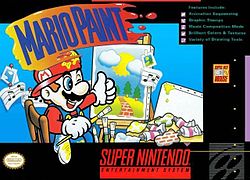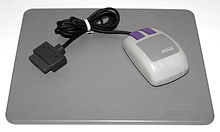- Mario Paint
-
Mario Paint 
North American box artDeveloper(s) Nintendo R&D1[1]
Intelligent Systems[2]Publisher(s) Nintendo Director(s) Hirofumi Matsuoka Composer(s) Hirokazu Tanaka
Ryoji Yoshitomi
Kazumi TotakaPlatform(s) Super Nintendo Entertainment System Release date(s) Genre(s) Art Mode(s) Single-player Rating(s) - ESRB: E
Mario Paint (マリオペイント Mario Peinto) is a video game created by Nintendo for use with the Super Nintendo Entertainment System, and was released along with the SNES Mouse peripheral device. The game's package was a larger than normal size in order to accommodate a plastic mouse pad which was included along with the SNES mouse.
Contents
Gameplay
Aside from being a basic drawing utility, Mario Paint allowed the user to make custom stamps pixel-by-pixel. Several publications, such as Nintendo Power, released how-to guides on how to create iconic Nintendo related stamps for use within Mario Paint. Besides just creating static pictures, a user could also make simple looping animations which could then be set to music created in the music generator. These animations painted by the user could only be viewed on a television screen, and while instructions were provided to users on how to record these to a video cassette recorder, there was no other way to export any of the work done in Mario Paint.
In addition, standard features consist of:
- 60 different textures and patterns
- 75 different stamps
- 15 customizable stamps
- Battery back-up capability for saving certain aspects of the game
- Nine different special erasers: Fade Erase, Water Erase (the picture becomes a grayscale and then disappears), Timed Erase, Rain Erase, Split Image Erase, Pixelated Erase, Blinds Erase, Rocket Erase, Abrupt Erase.
Mini-games
 The SNES Mouse and mouse pad that came with the game.
The SNES Mouse and mouse pad that came with the game.
Mario Paint also contains a fly-swatting mini-game, known as "Coffee Break" or "Gnat Attack," which is a fast-paced action game that takes full advantage of the Super NES mouse. The player controls a gloved hand (similar to the one seen on the title screen) holding a flyswatter, which must swat flying insects on the screen, before the insect stings the player's hand in one way or another. There are three levels, each with 100 insects and a boss. When you win the last boss it takes you back to level one and adds a small icon in the top left corner of the screen. There is no final level or reward, as the game will loop endlessly.
The title screen for Mario Paint proved to be a mini-game of sorts. The user was able to click each letter in the title to trigger a certain action. Certain letters would cause the music to change, have Yoshi run by on screen, make Mario shrink and grow, and even allow the user to temporarily paint the background. Also, occasionally, a star would fly across the screen very quickly which the user could click on and make it rain down lots of stars and change the music for the duration of this.
Totaka's Song in Mario Paint
Kazumi Totaka's Song is a 19-note song that appears in many Nintendo games. In Mario Paint, the song is an Easter egg, found on the front screen when a user clicks the O in "Mario Paint."[3] Although it has been referred to as the "Mario Paint song", its first appearance was in a Japanese-only Game Boy Game, X.
Reception and legacy
Mario Paint was rated the 162nd best game made on a Nintendo System in Nintendo Power's Top 200 Games list.[4]
The first cartoon (although not Flash like the rest of the series) of Homestar Runner was animated using Mario Paint.[5] A primitive Mario Paint made introduction video can be found in the museum of the site.
Mario Paint has been inspirational for developers. Masahito Hatakeyama, one of the designer for WarioWare D.I.Y., cites Mario Paint's drawing and music creation tools as inspiration for the drawing and music creation tools in D.I.Y., while several staff members of the development team cited it as the game that taught them the joy of developing video games.[6] One of the sound staff from Mario Paint, Hirokazu Tanaka, later went on to work on EarthBound. Some sound effects and musical instruments were used in both games.
Sequels
In 1997 a remake entitled BS Mario Paint: Yuu Shou Naizou Ban was released to Japanese markets via Satellaview broadcast. This version was modified such that the SNES mouse peripheral was no longer required.
In 1999, a series of games were released exclusively in Japan for the Nintendo 64DD under the title Mario Artist. The initial game was a launch title for the 64DD and was packaged with a mouse for the Nintendo 64. Throughout the series, the games featured ways for the user to create 3D polygonal models, insert images onto 3D models via a Nintendo 64 Capture Cartridge, and even share whose artwork via an online Communication Kit.
While no official sequel has been released in North America, Mario Paint makes a cameo appearance in WarioWare: Touched! as "Wario Paint," allowing the player to use the stylus to color various characters in the game. Also, you can listen to the Mario Paint Song with the toy "Turntable" in the "Toy Room". The fly-swatting game makes an additional appearance in the preceding game, WarioWare, Inc.: Mega Microgame$. The Wii Photo Channel features similar editing to Mario Paint, and even includes several of the special erasers.
The Nintendo DSi utilizes a similar music composing program.
WarioWare D.I.Y. allows players to record notes via the DS microphone, and apply noises and animals sounds to them, similar to Mario Paint's music creation. WarioWare D.I.Y. also uses a paint program similar to Mario Paint when the player makes a comic or graphics for their custom microgame. Also, when "Mario Paint" is entered as the name for a microgame or comic, the Mario Paint theme will play.
References
- ^ "クリエイターズファイル 第102回". Gpara.com. February 17, 2003. http://www.gpara.com/contents/creator/bn_102.htm. Retrieved June 13, 2011.
- ^ "Engaged Game Software". Intelligent Systems Co., Ltd. http://www.intsys.co.jp/english/software/index.html. Retrieved August 20, 2009.
- ^ "'Kazumi Totaka's Song'". NinDB. http://www.nindb.net/feature/totakas-song.html.
- ^ "NP Top 200". Nintendo Power 200: pp. 58–66. February 2006.
- ^ "Super NES" (SWF). homestarrunner.com. 1996. http://www.homestarrunner.com/supernes.swf. Retrieved January 3, 2007.
- ^ http://www.nintendo.co.uk/NOE/en_GB/news/iwata/iwata_asks_-_warioware_diy_16112_16113.html
External links
Mario series Arcade games Donkey Kong • Donkey Kong Junior • Mario Bros.Main series Console Handheld Spin-off games Pinball • Wrecking Crew • Mario Bros. II • Donkey Kong (Game Boy) • Mario's Time Machine • Hotel Mario • Mario's Game Gallery • Mario Clash • Wario Land: Super Mario Land 3 • Super Mario World 2: Yoshi's Island • Luigi's Mansion • Mario Pinball Land • Super Princess Peach • Luigi's Mansion 2Spin-off series Mario Party • Sports games • Role-playing games • Educational games • LCD games • Donkey Kong • Wario • Yoshi • Mario vs. Donkey Kong • Game & Watch GalleryRemakes Super Mario All-Stars • Super Mario Advance 4: Super Mario Bros. 3 • Super Mario 64 DSOther media Related articles Unofficial media Categories:- 1992 video games
- Drawing video games
- Intelligent Systems games
- Mario Bros. games
- Mario Universe games
- Nintendo Research & Development 1 games
- Super Nintendo Entertainment System-only games
Wikimedia Foundation. 2010.
